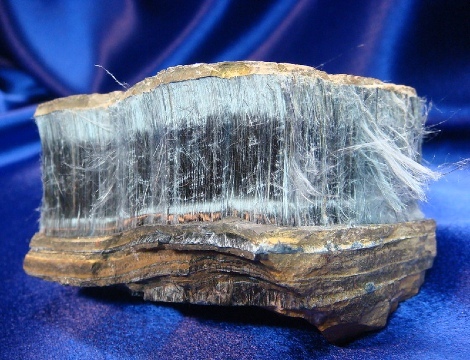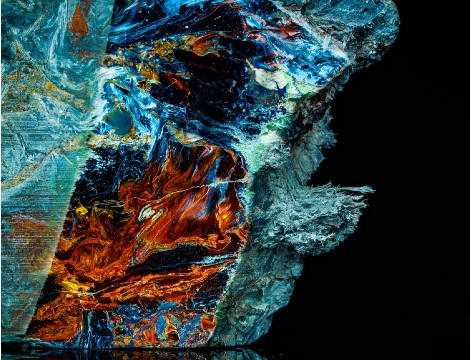Asbestos in Jewelry: Are You Wearing Asbestos Gemstones?
Awareness & ResearchWritten by Michelle Whitmer | Edited By Walter Pacheco

One of the lesser-known sources of asbestos exposure could be hiding in your jewelry box.
If you like to wear gemstone jewelry, you might be wearing asbestos without knowing it.
Gemstones are pieces of mineral crystal that have been cut and polished. Also known as gems, jewels or semiprecious stones, they are widely available online, in retail stores and in open-air markets to wear as jewelry or to collect as mineral specimens, the latter of which is popular among children.
While these gemstones are unlikely to result in dangerous exposure for those who wear them, they could result in minimal exposure if they break. Children who play with asbestos-containing gemstones run the risk of exposure if they damage, grind or break them.
The highest risk of exposure to asbestos through gemstones is faced by jewelers. Scientific studies have revealed cases of cancerous and noncancerous asbestos-related diseases among jewelers. The risk is low, but it remains a threat because it is legal to sell, buy and use asbestos-containing gemstones in the U.S.

Tons of fibrous gemstones, some of them containing asbestos, are traded in global markets on a daily basis. In the U.S., most gemstone mining is conducted by gem clubs, individual collectors and hobbyists. The businesses that sell natural gemstones in the U.S. are typically small, averaging about three employees, and they operate independently.
The process of cutting, shaping and polishing gemstones is known as lapidary. Lapidarists and jewelers use high-speed lapidary saws and abrasive rotary equipment to create polished gems for use as pendants, charms, beads and ring inlays. Lapidary of asbestos-containing gemstones can release significant amounts of asbestos fibers into the air.
Gemstones Known to Contain Asbestos
Certain gemstones used to make jewelry are known to contain asbestos, including:
- Tiger’s eye
- Arizona tiger’s eye
- California tiger’s eye
- Cat’s eye
- Hawk’s eye
- Silkstone
- Pietersite
- Binghamite
- Yuksporite
- Denisovite
- Tokkoite
- Grossular garnet
- Hessonite
- Brucite
- Natrolite
- Mesolite
- Scolecite

In 2003, geoscientists at Pennsylvania State University used high-powered microscopes to study the structure and composition of tiger’s eye. Prior to the investigation, mineralogists assumed that tiger’s eye formed after crocidolite asbestos was replaced with quartz.
Penn State’s researchers discovered that tiger’s eye forms when veins of quartz fill in breaks that form in crocidolite asbestos. Rather than replacing crocidolite, the quartz forms a vein alongside it. As the iron in the crocidolite oxidizes, it develops the brown and gold colors that tiger’s eye is known for.
How Are Jewelers Exposed to Asbestos?
The primary ways jewelers have been exposed to asbestos include:
- Sanding, cutting and shaping asbestos-containing gemstones.
- Manufacturing asbestos-containing soldering molds that shape jewelry pieces to be soldered (fused together). The soldering board on which this work was performed was also made of asbestos.
- Cutting asbestos sheets to line casting molds that were baked in ovens to make pieces of jewelry.
People who worked around these activities, especially anyone who swept asbestos dust in jewelry shops, were at risk of asbestos exposure.
Those who collect, handle and transport raw asbestos-containing gemstones are also at risk of exposure.

How Can Jewelers Avoid Asbestos Exposure?
Jewelers should do the following to limit asbestos exposure:
- Avoid working with gemstones known to contain asbestos.
- Use a respirator mask with a high-efficiency particulate air filter or an N-100, P-100 or R-100 mask.
- Use tight-fitting protective eyewear to prevent asbestos dust from causing eye irritation.
- Work in a properly ventilated area, which may include using a ventilation system in a jeweler’s workshop.
Jewelers working with asbestos-containing gemstones are required by law to double-bag asbestos waste in 6 milliliter bags, place it in a sealed plastic container, label it properly and pay to dispose of it in a government-designated landfill. Those who do not follow these regulations face steep fines.
Mesothelioma in the Jewelry Industry
Asbestos in jewelry has exposed jewelry workers and caused some of them to develop asbestos-related diseases, including mesothelioma cancer. These cases were connected to asbestos used in soldering, which is a process that connects pieces of jewelry together.
A 1992 case report published in American Journal of Industrial Medicine reported on a case of mesothelioma in a commercial jewelry worker. A 61-year-old man was diagnosed with pleural mesothelioma and his only known exposure was manufacturing asbestos-containing soldering molds.
For 35 years, up until three weeks prior to his mesothelioma surgery, the patient made asbestos soldering molds at a costume jewelry production facility by hand-mixing asbestos powder with plaster of Paris and water. Analysis of his lung tissue revealed both chrysotile and amosite asbestos fibers.
Other cases of cancerous and noncancerous asbestos-related diseases have been documented in jewelry industry workers:
- Another case of mesothelioma was documented in a 44-year-old woman who worked with asbestos-contaminated talc for 20 years in a costume jewelry facility.
- A mesothelioma patient involved in a hospital study reported that he worked in the jewelry manufacturing industry.
- A cluster of mesothelioma cases was documented among Native American silversmiths.
- Cases of pleural plaques and asbestosis were previously reported among jewelry workers in Rhode Island.
- Pleural plaques and asbestosis have been documented among jewelry workers in Denmark.
Gemstones have fascinated people for centuries. They not only like to collect them and wear them as jewelry, but some people believe they contain metaphysical qualities. For example, the gemstone known as green zebra jasper, which contains chrysotile asbestos, is said to balance out the lives of those who possess it.
The risk of asbestos exposure among people who wear asbestos-containing jewelry is low, but jewelers and lapidary workers face a higher risk of exposure and long-term health consequences.






